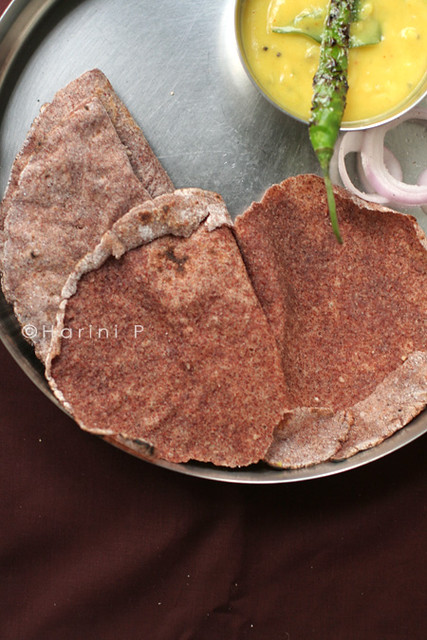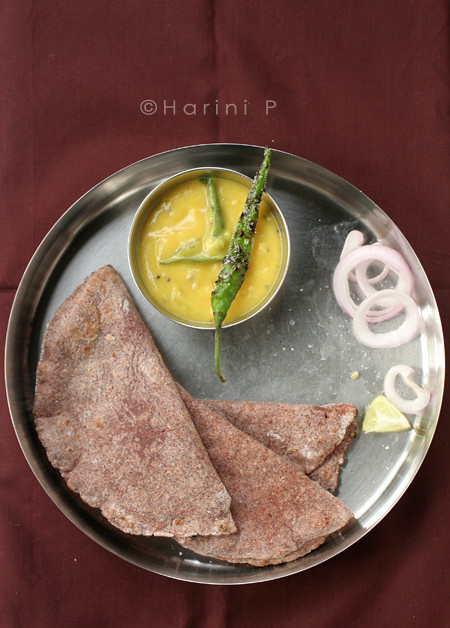Nachni chi bhakri ~ Finger millet flatbreads from Maharashtra
I often acknowledge that I am forgetful but did not realize how much till I noticed that the latest addition on my side bar that says "coming up next" has been there since the last three posts! I have been meaning to post the method to make the perfect gluten free flatbread for quite some time now, since Shubhangi (my 'Woman Friday') taught me to make them. Some time soon I will ask her to prepare them, while I take a video. It is an art to make a beautifully puffed gluten free flatbread and comes with practice. It took me quite a few weeks to get from the stage of making hard crackers to the soft pitas I am able to make now! The texture of a good bhakri (local term for gluten free flatbreads) is a pleasure to the palate so please pursue if you are not able to get them right. It is not that difficult and is so good for your physical well being!
Shubhangi has been working with me now for over two years and is a very industrious, honest worker. She cleans the dishes and does the floors in my house and somehow she also seems to make the work look quick as well as very pleasurable! It is only when I climb up the stool and start cleaning the fans or the mesh that I go back to believing that the job is boring. I suppose that is what a dedicated worker can do and I respect her a lot for her attitude towards work. It is a very rare quality, especially amongst domestic workers. Shubhangi is a Maharashtrian and her staple diet consists of rice, gluten free flours and wheat.
Unlike the North Indians, Maharashtrians make a variety of flatbreads using gluten free flours. This is because the State ranks high among producers of jowar (sorghum), bajra (pearl millet) and ragi (red millet or finger millet). In earlier times when the breach between the rich and poor classes was wide, the former would shun jowar and ragi for regular use as these were cheap and considered low. The latter depended on them for the same reason. It was a rather unfortunate view, because now it has been established that gluten free grains are naturally better suited for digestion and are not just "for the birds" (it is a common practice in West India for people to scatter jowar out of their windows to feed the birds). While some areas in the State are suitable for production of rice, others are only suitable for jowar and ragi as the climatic conditions required for cultivation of these grains are very different from one another.
Shubhangi belongs to the jowar and ragi belt, and does not believe in buying the flours off the shelf like most villagers, though she has been in the city for nearly a decade. She buys or brings the grains from her village in bulk, picks them clean, rinses the dirt off in many turns of water and spreads it in the shade to cool. Then she gets it ground at a mill and also gets me my portion of these flours. Earlier I followed a similar practice with store bought grains but since I used very less of the grains (no one liked the crackers, you see!), I found that most of the flour would go rancid and thrown into the bin. Now she has relieved me from that chore too!
I had nearly stopped trying to make gluten free flatbreads till one day, when Shubhangi, like a good teacher kept passing tips and encouraging me till I got them right. If I made rotis (whole wheat flatbreads) for the next few days, she would remind me and get me back to being the student! In the beginning when I would prepare the bhakris under Shubhangi's watchful eyes she would often say, "Don't press or try to flatten to spread them. Soft and quick strokes with ONLY your fingers" or "Good, good! But not enough. You must pay attention to the one on the griddle too while making. Don't let even one bhakri go waste." It used to give the kids a kick watching me getting ticked off!
Like cycling, one day while making your bhakris and watch it puff, you will suddenly realize the correct pressure that makes it happen and then, you will have your eureka moment. Till then? Just envision the hard flatbreads as lavash crackers and serve them with exotic dips! I really hope that it doesn't happen as often as it did to me. It took me 8 stops at the cracker stage to get here.
What is a good bhakri?
Bhakri is the local name given to any flatbread made of gluten free flours. So we have tandula chi bhakri (Rice flatbread), nachni chi bhakri (red millet flatbread), jwari chi bhakri (sorghum flatbread) and bajri chi bhakri (pearl millet flatbread). A good bhakri will be only about 2mm thick and will puff like a pita when placed on fire. It will be soft to handle and will easily tear.
 A good bhakri puffs up completely and can be torn into two layers
A good bhakri puffs up completely and can be torn into two layers
Serving bhakri
Ideally a bhakri gets combined with pitla or zunka (in which case a drink of kokum kadhi should complement the dish), but tastes good with any vegetable preparation as long as it has some juice.
Which way do you like it?
The rustic version contains salted, charred green chilli and a good amount of onion rings as well as an accompaniment to complement the soft texture of the bhakris. Take care to choose mild chillies or you might as well keep some jaggery handy! A kokum kadhi completes the picture!
If the recipe I am sharing works well for you, do think of Shubhangi and send some good wishes her way through Nature's wireless communication service called 'Good Vibes Incorporation'.
Dish: Nachni chi bhakri
Time : 15 to 20 minutes from boiling the water for the dough to serving the preparation.
The recipe proportion below yields about 15 bhakris measuring about 5-6" in diameter.
Ingredients:
2.5 cups red millet flour (Finely ground - sieve if coarse) + extra flour for dabbing
2 cups water + 1/2 cup in a cup for dabbing
(Do not use salt as it will not incorporate well)
Tools and equipment:
A wide vessel for making the dough
A vessel to heat the water
A spoon to mix the flour and water
A work surface to pat the bhakris. Could be wooden, marble or just a level steel plate.
A griddle to roast
A pancake turner
Method:
Heat the water in a vessel and bring it to a rolling boil. This is essential because the flour is gluten free and only heated water will help in forming the dough.
While the water heats, place the flour in a wide vessel.
Pour 3/4 th of the boiling water all over the flour and quickly start incorporating the flour into it.
Press the flour with the spoon as you work. This helps the water to get absorbed.
After a few minutes the dough cools down from hot to warm. Time to get your hands dirty.
Press and bring the dough together with one had while holding the vessel with the other. Sprinkle more of the reserved hot water if needed to form a dough of firm cylinder. It should feel soft on the surface and should easily sink if you dig with a finger. Too much water will tear the rotis as you make them. Too less water will make a hard dough and you won't be able to pat it into a circle.
Keep about 1/2 cup of flour in a plate to use for dusting.
Pinch off dough about the size of a lime and roll into a sphere between your palms. Flatten slightly to the size of a cookie. Place it on the dry flour and dust both sides.
Heap about a tsp. of dry flour in the center of your work surface. Place the disc on the heap and with pat with your fingers following a circular pattern so that the disc spreads as you pat. Strokes should be quick and firm but not hard. Lift immediately and do not press as you stroke, otherwise the disc might stick to your work surface and make it difficult to go any further.
If you want to use a rolling pin, see that you roll in one direction only and do not press. It should be a light roll. If the bread tears, just patch it up again and proceed without applying pressure in that area.
Dust your fingers in between lightly and keep rolling your bread, if it does not rotate on its own. With experience it will.
Continue in this manner till it is about 2mm in thickness and 5 to 6" in diameter.
Lift carefully and dust of excess flour on the side that was placed over the surface.
Flip on a hot griddle with the dry floury side facing upward. Dip your fingers in water and spread it to wet the dry surface that faces you. Do not pour water, just about a tsp. will be enough.
After cooking one side for about a minute on low heat, use a flat pancake turner and flip the bhakri.
Increase to high heat and let cook for about a minute till the water turns dry.
Now remove the griddle and using a pair of chapati turners flip again over stove ON HIGH HEAT. The bhakri will puff up just like a pita bread into a balloon.
If this is your first time keep the rest of the dough covered or it might dry.
Repeat with the rest of the dough.
The instructions were not meant to deter beginners. I just thought of what I wanted to know when I started off and tried giving the little details that bothered me.
Hope it helps you too. And don't forget Shubhangi if you get them right!
Did you know that recent studies show that milk does not supply calcium to the body and that most milk consumers suffer from weakness of the bones due to regular intake? Why not switch over to two ragi rotis a day and fortify your bones with calcium?
Bhakris with other flours on the web:
Khaugiri - Bajri chi bhakri (Pearl millet flatbreads)
Vegan Treats - Rice flour bhakris
Aarti's Corner - Jwarichi bhakri (Sorghum flatbreads)
Wish you a happy Monday!Labels: Bhakri, Finger millet, Flatbreads, Gluten free, Gluten free flatbreads, Harini P, Maharashtrain cuisine, Nachni, Nachni chi bhakri, Ragi, Red millet, Sunshinemom, Tongue ticklers
